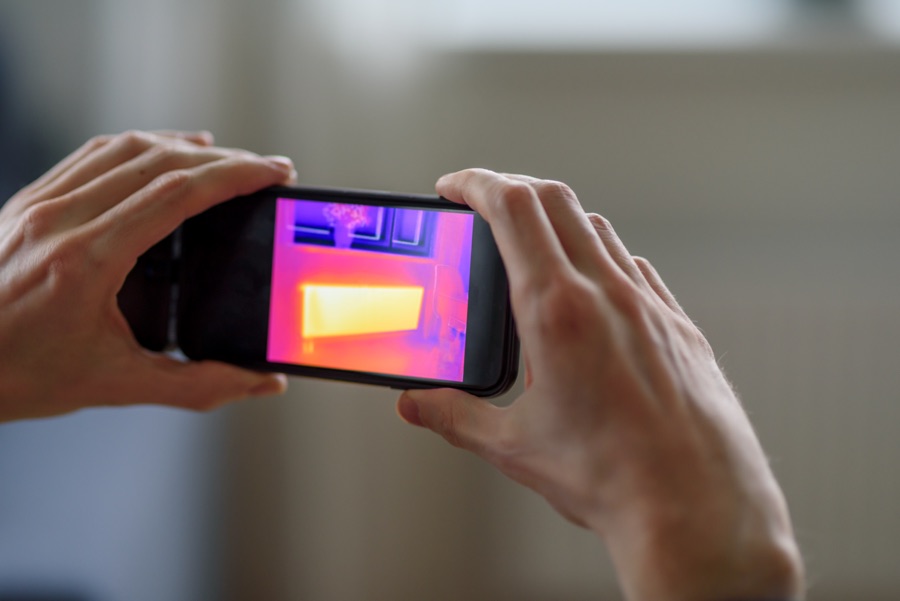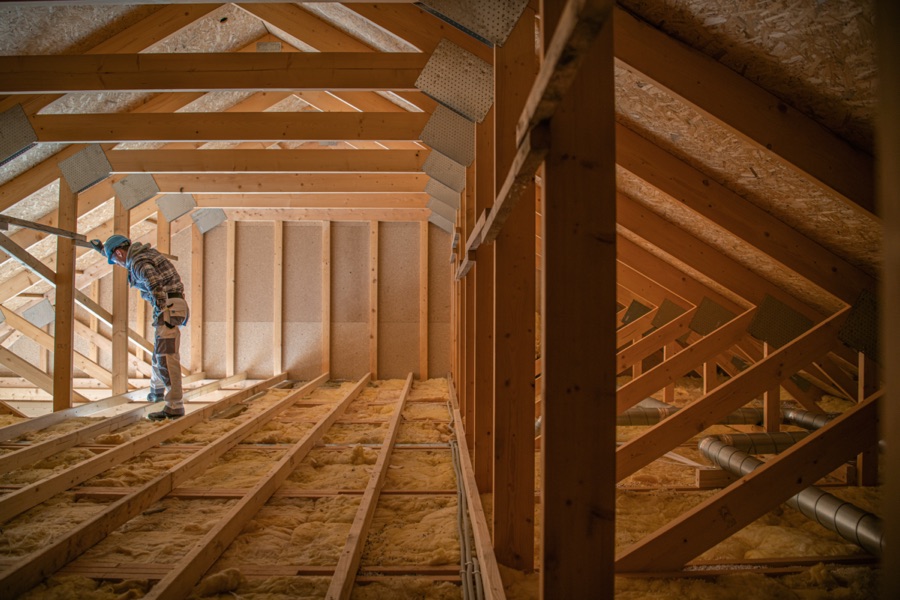
Home > Blog posts > All you need to know about thermography
All you need to know about thermography
The quality of insulation and ventilation are essential to your home, not only in regards to the occupants’ comfort, but also when it comes to energy efficiency. Thermography is part of the methods that were developed in order to produce a quick diagnosis of different problems, including insulation and energy efficiency.
Find out more about this method and its advantages, along with the average prices for an inspection.
What is thermography?
First and foremost, what exactly is thermography? How does it work?
This process utilizes thermal imagers that record the heat energy emanating from matter and objects through infrared radiation. The result is called a “thermogram”; this is an image that shows different color gradations according to the recorded temperatures.
On the thermographic image, cold hues and warms hues will appear according to the recorded temperatures. In fact, the whole process is quite simple: the hotter the object or matter, the more it emits heat and reflects infrared rays.
The coldest point is represented with the color black, while on the other end of the spectrum, white represents a very high temperature. From the coldest to the hottest, colors vary as follow:
- Violet
- Blue
- Green
- Yellow
- Orange
- Red
Contact us now for a roof inspection

Thermography is a method used in various sectors, including the medical field. It is so precise that it can also allow medical professionals to detect certain types of cancers.
When it comes to building inspections, for example, this method is extremely efficient, allowing for quick and precise assessments without the need for demolition or other alterations to an existing structure.
As a general rule, contrasts in colors mean that something is not normal. For example, when observing an exterior wall in the winter and seeing red or orange hues, this usually means that there is a loss of heat.
Although thermography yields very precise results, several factors must be taken into consideration, including thermal properties for each material and the rays they emit.
Whether in a home or in a building, thermography can help detect:
- Waterproofing problems
- Insufficient thermal insulation
- Water infiltration
- Condensation
- Leaks, including in the heating systems
In fact, this method can even help detect pests like cockroaches, ants or rodents. This makes it the ideal method to help identify where they are coming from and also how to proceed to the extermination.

How can thermography help detect energy efficiency problems?
Energy efficiency is often a concern for those who care about the environment, or simply their wallet. In fact, you probably already know the impact of poor energy efficiency and how it can significantly influence costs related to electricity.
Moreover, if you are noticing abnormally high Hydro-Quebec bills, like when compared to a previous home or other people around you, this can mean that you are having energy efficiency performance issues.
Even if you suspect an energy efficiency performance problem, it might be difficult to figure out exactly where it is coming from! This is where thermography comes in handy, offering an interesting solution.
Thermography for buildings is often completed in the winter, since it is easier to identify areas where there is heat loss from the interior to the exterior. It then allows you to identify air leaks that often form around doors and windows.
By identifying exactly where the leaks are, you will be able to seal them and improve your energy efficiency. Your home will lose less heat in the winter, which means that your heating system will no longer have to produce as much energy!
This method also allows to detect insulation problems, which are another factor that has an impact on your energy efficiency performance. These problems can stem from poor insulation in the walls or the roof. Thermography on the walls and the ceiling will help you see more clearly where the energy is being lost.
Finally, thermography can also be used on heating, air-conditioning or furnace systems themselves. An abnormal heat zone could be the sign that there is insufficient energy efficiency or that your equipment is not performing as it should.
By identifying leaks, problems with insulation or your equipment’s performance, infrared thermography on your building will help you obtain a precise diagnosis. It can truly help you improve your home’s energy efficiency and –finally- reduce your electricity bills for good!

How to detect insulation deficiencies in your home with thermography?
As we have briefly mentioned, thermography will help you identify insulation problems, among other things. Other than leaks, insulation is one of the main sources of energy loss. It causes you to loose heat in the winter and make your home too hot in the summer!
In other words, an insulation problem can affect your home’s energy efficiency on top of making it less comfortable to live in. Your house is probably not properly insulated if you notice that:
- Your floors are abnormally cold, and so are the walls
- The rooms all vary in temperature
- Your roof thaws quickly and forms stalactites
- The humidity levels in your home are high and you notice mold growth
These insulation problems can come from different places within the structure itself. Thankfully, a thermographic inspection will help you better identify where the problems come from by detecting the differences in temperatures.
Insufficient insulation can cause problems like temperature variations but also, consequently, humidity, condensation and mildew, which are all things that experts can detect.
The main advantage of thermography is that it will allow you to detect insulation deficiencies without having to open up the walls! This is a much quicker and less expensive method, without forgetting that it is also much more efficient.
The attic, which is the empty space between the building’s roof and structure, plays a crucial role in a house’s insulation. Thermography can help you understand if your attic is functioning the way it should. This diagnostic tool will help you figure out exactly what should be done.
By fixing insulation problems, you are also preventing infiltration and icicles from forming on your roofs’ edges and ensuring a longer lifespan for your roof covering. A simple diagnosis can make a huge difference!

Who can complete these kinds of tests?
Although a thermogram reading might seem very simple at first, it does require thorough training. Using the actual camera and understanding the results require an expert’s touch.
Thermography inspectors are certified professionals from the American Society for Non-destructive Testing (ASNT). They can obtain a level 1 certification, allowing them to use the camera, or a level 2 certification, giving them the authorization to complete a full report.
In fact, you can ask just about any contractor to complete the inspection or even do it yourself. But this does require precise skills and knowledge; otherwise chances are the results will be unreliable or inconclusive.
We have also previously mentioned the different material properties; for example, aluminum and brick do not absorb and diffuse heat in the same way. This is information that must be taken into consideration when you are interpreting the results.
After an inspection, experts will provide you with a detailed report, which includes:
- Locating precisely where the problem is coming from with pictures (infrared and digital)
- Detailed explanations of the observations
- Diagrams representing the issues to be addressed
- The different interventions that should be done to correct the situation
- Explanations for the recommended methods and the implications
The report will also include all of the information related to how the inspection was completed, along with the complete identification of all of those involved and responsible, including details regarding their certifications.

How much does a thermography analysis cost?
Thermography analysis is a non-destructive technique that allows you to save on several costs.
The costs related to thermography varies greatly according to several factors. Inspecting a wall or complete building also does not represent the same amount of work. In average, for a single-family home, costs related to an energy efficiency report are estimated at around $ 525. This not only includes the use of cameras, but also a full-length report with professional recommendations.
Costs will also be higher or lower depending on the overall surface of your house and what you wish to include in the inspection. For example, a thermographic inspection of the electrical systems can cost between $ 300 and $ 500.
In some cases, a full-length in-depth analysis can be close to $ 1,000, depending on factors like the area that is covered and the contractor’s fees. Costs will obviously be higher for commercial buildings.
In short, thermography is a quick and efficient method helping you detect problems related to energetic performance and insulation.
Has your inspection revealed a problem with your roofs’ insulation? Do not hesitate to contact Clinique de la Toiture FCA for a quote. Our roofers can address these problems, helping you improve your home’s energy efficiency and your roof’s durability.
Don't wait any longer: ask us for a quote!
Get an estimate in just 2 quick steps!
*Please allow a minimum of 24 hours for your request to be processed. Thank you for your understanding!
Need help?
Leave us your email address and we will contact you as soon as possible to assess your needs!
Put an end to your water infiltration your clogged drains your roof problems
Leave us your email address and we will contact you as soon as possible to assess your needs!
